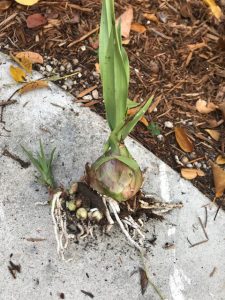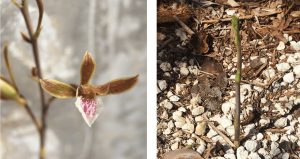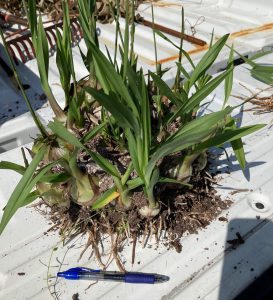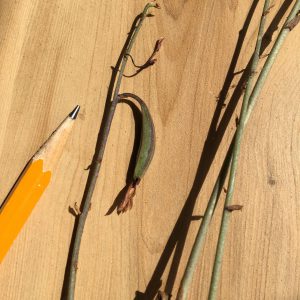
Eulophia graminea, a terrestrial orchid commonly known as Chinese ground orchid, was first discovered in south Miami in 2007. By 2010, it had spread to seven more counties, including one known occurrence from No Name Key (Pemberton, 2013). According to FDACS (Florida Department of Agriculture and Consumer Services) Tri-ology report covering January through March of 2019, E. graminea had been documented from 13 Florida counties at that time. Current data, based on vouchered specimens contained within the Florida Plant Atlas and EDDMapS, a web-based mapping system for documenting invasive species, indicate its presence in 23 counties. The northernmost-vouchered occurrence is in Volusia County; however, Dr. Chris Mable, with the University of Florida, stated there is a known, large population near Jacksonville, in Duval County (personal conversation).
Identification
Mature individuals have large pseudobulbs that can appear in clusters, or occur singly in younger plants, and are partly buried in the soil (Figure 1). A thick mass of white roots grows from the base of the pseudobulb. The mature pseudobulb produces a single shoot with three to five grass-like leaves that die back in the winter (Anderson, 2019). The leaves are deeply grooved at the midrib (vein along the midline of the leaf) and appear to fold in. The inflorescences begin to appear in the spring and summer and are usually 30-80 cm tall and are branched, containing as many as 60 small flowers (Figure 2). Individual flowers range from 1.5-2.5 cm across, spreading, with lance-shaped, long-pointed sepals and somewhat broader petals (Figure 3). Flowers are greenish with dark purple, netted veins (North American Orchid Conservation Center 2021). The labellum, also called the lip, is lobed; the mid-lobe is pale rose-colored, with round, wavy margins. A nectar-producing spur is present at the base of the flower.

Orchid Distribution

Eulophia graminea is native to tropical and sub-tropical regions in Asia and is listed as a threatened species in Sri Lanka. In its native range, it occurs in diverse habitats including sandy beaches, lawns, roadsides, secondary forests and parks, coastal grasslands, and other exposed areas (Pemberton, 2008). In 2001, E. graminea was discovered in northern Australia and is now naturalized. In Florida, it is most often associated with mulched landscapes and wood chip substrates. However, it can quickly form dense monocultures (Figure 4) and has spread into some natural areas in the Keys such as tropical hardwood hammocks, pine rockland habitats and coastal strands (UF/IFAS Center for Aquatic and Invasive Plants 2021). E. graminea has been found growing in bare earth, sand, rock and even within cracks in concrete.
Many orchids are myco-heterotrophic, meaning they rely on a symbiotic relationship with root-penetrating, mycorrhizal fungi, and derive all or part of their nutrition from the fungi rather than from photosynthesis at some point in their life cycle (or throughout their life). Since orchid seeds lack energy reserves, this relationship is critically important in orchid germination. This may also contribute to lower-than-normal invasion rates into new geographic regions by the plant family Orchidaceae.
In a recent study, it was proposed that orchids that can invade new ranges are more generalized in their mycorrhizal associations than their native congeners (organisms in the same taxonomic genus) and are less likely to be infected with pathogenic fungi in the new range (Downing, 2020). To test this, the researchers identified the fungal associations with native Cyrtopodium punctatum (Cowhorn orchid) and Eulophia alta (Wild coco) in Florida, to that of two invasive orchids, Cyrtopodium flavum and Eulophia graminea. They found that the invasive orchids associated with a greater diversity and wider range of orchid mycorrhizal fungi than the native species and they also harbored fewer pathogenic fungi. Downing et al. concluded, the ability to form generalized and positive below-ground biotic interactions and ability to resist antagonistic relationships likely contributed to the range expansion of the invasive orchid in south Florida (2020).
Control
In conversations with land managers, biologists, and scientists specializing in invasive weed management, hand and/or mechanical removal remains the best option for control, making sure all vegetative parts (pseudobulb and roots) are removed, so there is no regrowth of the remaining parts. Tiny, microscopic seeds are enclosed in seed capsules, and disperse by explosive dehiscence, a form of seed dispersal that flings seeds far from the parent plant (Figure 5). So, if seed capsules are present, carefully cut and bag the seed heads prior to removal of the plant. Glyphosate, the active ingredient in the common Round-Up herbicide, does not seem to be very effective, according to Dr. Marble. Once these are pulled up from the landscape, all parts should be placed in a garbage bag and put into waste receptacles. E. graminea should not be put in with other landscape material or yard waste that is recycled or composted; this could contribute to additional spread of the species. Some land managers and homeowners have reported Key Deer herbivory of the flower spikes.

To help in the fight against invasive species spread locally, these plants can be reported to the web-based mapping system EDDMapS (http://www.eddmaps.org), or by downloading the smartphone app, IveGot1. Both are supported by the Center for Invasive Species and Ecosystem Health at the University of Georgia. These tools aid land managers, conservation biologists and scientists in mapping the spread of invasive species and is the first step towards mitigation of these species. E. graminea has been designated as an Early Detection and Rapid Response (EDRR) species by the Florida Keys Invasive Exotics Task Force. EDRR is a multi-agency, rapid response effort led by the United States Geological Survey (USGS) agency to find and eradicate potential invasive species before they spread and cause harm.
Special thanks to Beth Bergh, Monroe County Land Steward, and Janice Duquesnel, Florida Park Service Biologist, for their contributions to this article.
Banner image credit: James Orrock, UF
References:
Anderson, P. J. 2019. Botany Section. P.J. Anderson and G.S. Hodges (Editors). TRI-OLOGY 58(1): 4. (Accessed 1 Feb. 2021.)
Downing, J. L., L. Hong, M. K. McCormick, J. Arce, D. Alonso, and J. Lopez-Perez. 2020. “Generalized Mycorrhizal Interactions and Fungal Enemy Release Drive Range Expansion of Orchids in Southern Florida.” Ecosphere. 11(8):e03228. 10.1002/ecs2.3228.
EDDMapS. 2021. Early Detection & Distribution Mapping System. The University of Georgia – Center for Invasive Species and Ecosystem Health. Available online at http://www.eddmaps.org/; last accessed February 1, 2021.
North American Orchid Conservation Center. 2021. “Eulophia graminea Lindl.” Accessed February 2, 2021. https://goorchids.northamericanorchidcenter.org/species/eulophia/graminea/
Pemberton, R. W., T. M. Collins, S. Koptur. 2008. “An Asian Orchid, Eulophia graminea (Orchidaceae: Cymbidieae), Naturalizes in Florida.” Lankesteriana. 8(1): 5-14. https://www.redalyc.org/articulo.oa?id=44339815002
Pemberton, R. W. 2013. “Rapid Geographic Spread of the Alien Orchid Eulophia graminea in Florida.” Selbyana. 31(1): 47-51.
UF/IFAS Center for Aquatic and Invasive Plants. 2021. “Eulophia graminea.” Plant Directory. Accessed February 2, 2021. https://plants.ifas.ufl.edu/plant-directory/eulophia-graminea/
Wunderlin, R. P., B. F. Hansen, A. R. Franck, and F. B. Essig. 2021. Atlas of Florida Plants (http://florida.plantatlas.usf.edu/). [S. M. Landry and K. N. Campbell (application development), USF Water Institute.] Institute for Systematic Botany, University of South Florida, Tampa.
 1
1
